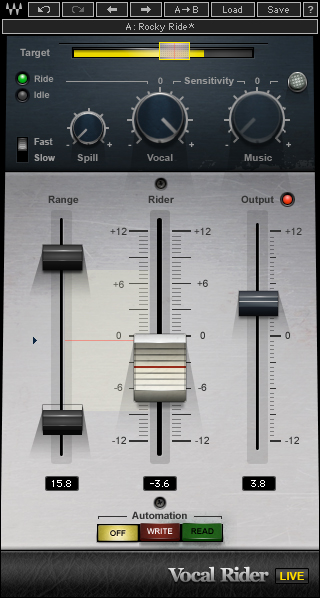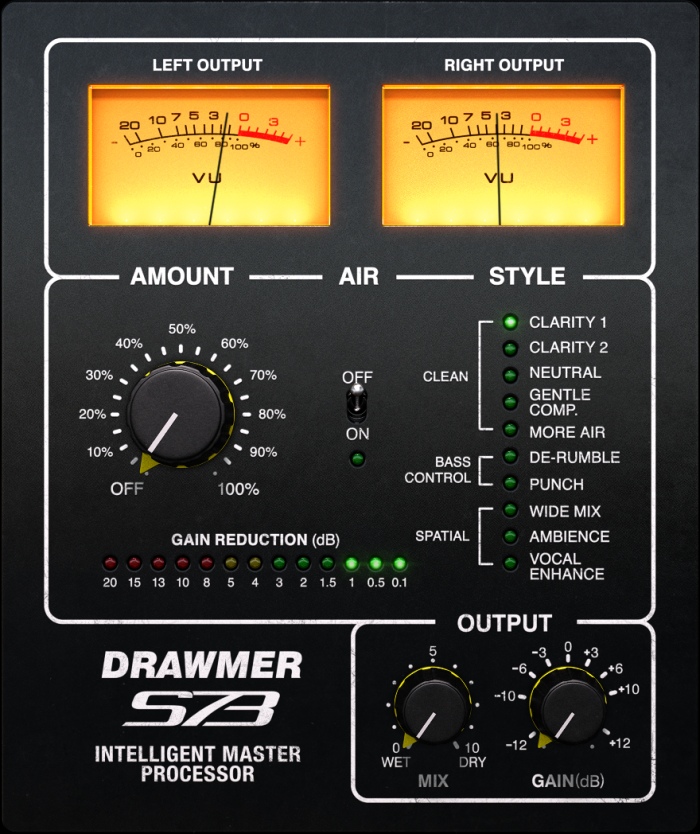4 “Magic” Plugins That Might Just Fix Your Mix After All
All artforms have their elitists, and music is certainly no exception.
Elitism in music production extends beyond the dictates of the listeners, to the writers, creators, technicians and even the tools they use to create.
For many of those behind the scenes, all the honor and prestige is in adhering to tried-and-true processes and devices. For others, the ends justify the means, and a tool is no more than just that.
Plugins can replicate the design and parameters of standard equipment like EQs and compressors, but they can also simplify some of the more difficult concepts and make these techniques available to users of all levels.
While true mastery of any approach requires an understanding of the underlying process, there plenty of tools to get quick and effective results, even if there is a bit of “magic” going on behind the GUI.

Using the Waves Vocal Rider can feel a little like cheating. But by that logic, isn’t using automation at all “cheating” to begin with?
The Waves Vocal Rider plugin could be the posterchild of “Cheating” plugins.
Doing vocal rides and writing automation is one of the key finishing touches of a mix, in which the mixer uses his or her ear and artistry to keep the vocal right in the sweet spot through the whole song.
Wouldn’t a plugin that could do that automatically lead us down the slippery slope of removing all the art from mixing? Should we just give up and let the robots mix for us??
Fortunately, it’s not that serious.
The Vocal Rider does just what its name implies: It takes incoming signal and adjusts it to stay inside a certain decibel range.
It also accepts a sidechain input, allowing you to keep the relative level of your main signal to the sidechain signal at constant level, thereby riding your vocal in relation to the rest of your mix. You can tweak the results using the “Sensitivity” dial and write the resulting data to your DAW’s automation track for further editing if you like.
When used as intended, Vocal Rider would live at the end of your plugin chain, but I have found it even more useful at the beginning of my chain, as a clean dynamic control providing a consistent level to the rest of my processors.
While most DAWs have some form of clip gain system, this is automated, quicker, and especially great for performers with less than stellar microphone technique.
The results are surprisingly good by itself, and with the ability to manually tweak the automated moves that the plugin suggests, you can easily bring a some of the human touch back to your final decisions on vocal rides. And for quick and rough mixes, even a robot’s first pass at vocal automation is far better than doing no vocal automation at all.
Remember: Once upon a time, even vocal automation itself was once considered “cheating”. Now it’s just another tool we use to creative effect.

Slate’s FG Bomber is a remarkably simple-to-use embetterer of sound with a lot going on under the hood.
Slate Digital has a wide range of analog modeling plugins, mostly recreations of existing equipment, but their FG Bomber is a totally unique design that they’ve dubbed a “Dynamic Impact Enhancer.”
Drawing elements of analog compressors, saturators, filters and harmonic generators, The Bomber is designed to “make make the elements of your mix ‘extrude’ from the speakers.”
There are only four controls here, the foremost being “Drive”, which adjusts the amount of signal sent to the processor, and ”Intensity”, which is essentially a mix control.
There is also a Tone control which selects between one of three presets (Present, Fat and Tight), and an Output Gain control.
Slate suggests that you drive the VU meter to the Bomb icon in the middle as a starting point, driving it further to add more depth and sustain. The Tone descriptions are up for interpretation, as words like “Fat” and “Present” tend to be, but all three are usable settings in the appropriate setting.
Just two knobs and three settings can get you the right-sounding saturation so much of the time. A pretty impressive feat, from a lot of unseen “magic” happening under the hood.
An interesting side-effect of the analog-to-digital transition of the last thirty years is the proliferation of Presets and their impact on the way many mixers work today.
Analog gear just doesn’t come out of the box with ready-made “Pop-Vocal” or “Huge Kick” settings. Presets are a great starting place to dial in your sound, although the argument could be made against them for potentially contributing to homogeneity in modern sounds and music in general. I am not here to make that argument.

One variable control knob, one style select switch. All you have to know is what kind of sound you like to hear. Is that fair?
Softube’s Drawmer S73 is billed as an “Intelligent Master Processor.” It draws design inspiration from Drawmer’s 1973 multi-band compressor, and boils things down to one knob, which controls the amount of compression, and a selection of “Styles” which provide a wide range of EQ curves.
There is also an “Air” switch for a high frequency boost, and lastly Mix and Gain knobs. The Styles are broken up into three groups: Clean, Bass Control and Spatial, and are all varied enough that you’re sure to find a style that suits you.
Those looking for a full-featured multi-band compressor will want for much more control. But those who are new to the concept, or looking for quick and easy processing should take a look that S73.
I have a rather elaborate Mix Bus chain that I like to use, but for quick rough mixes it is totally impractical, so the S73 is a great solution here. Ten different Style presets, plus the Air switch make this a very flexible compressor and dead simple to use.
Prime Studio is a very cool Austrian-based recording studio that also has their own line of plugins. These folks know their gear, they have an incredible collection of vintage and modern equipment. This enviable collection is the basis of their plugin line.
Their Charly plugin models a custom summing amp, which according to Prime is “heavily modified and customized to our specifications by one of Europe’s leading gear gurus. Meticulously measured now available in the digital domain too. Add air, punch and sticky glue to flavor your tracks with analog warmth and character just using one big knob.”
That “one big knob” is the only control on the plugin. Simply turn it up and drive the virtual tubes. Charly adds size and color to your signal, and the more you drive it, the more it gives you a nice midrange push. It also does wonderful things to the stereo field, adding depth and clarity.
I’m a long time Charly user, it’s been the first plugin on my mix buss for over a year now. It’s also free when you sign up for Prime Studio’s mailing list. (Scroll to the bottom of their website to find the link—it’s not on the Plugins page.)
Sometimes, “Cheaters” Do Prosper
Is the simplicity of these plugins “cheating?” Maybe. But that implies not only that there is a zero-sum competitive aspect to making music, but also that there is a “correct” way to make it—and that’s just not a concept I believe in.
The movement to computer-based recording, combined with the ever-increasing affordability and quality of software has seriously democratized the music making landscape.
These are just a handful of great tools to make the mixing process easier, and if the “magic” sounds good, does it really matter how you got there?
Please note: When you buy products through links on this page, we may earn an affiliate commission.









charlie
April 20, 2017 at 5:49 pm (7 years ago)So Prime Studio is what became of the Acustica people? Their plugins look cool, but where did they come up with that spelling of ‘Charly’?
Soundguard
April 20, 2017 at 7:44 pm (7 years ago)As I know, Charly is the name of the guy who modified the custom hardware unit and no, these are not the Acustica people. It’s a recording, mixing, and mastering facility in Austria.
charlie
April 20, 2017 at 7:46 pm (7 years ago)Thanks for that. It does reference Acustica Audio in several places on their site.
Paul Wade
April 20, 2017 at 8:13 pm (7 years ago)Great article thank you!
Paul Wade
April 20, 2017 at 8:15 pm (7 years ago)The relationship is that Prime Studio Austria licensed the volteric kernel impulse technology from Acustica.
Joel Glaser
April 21, 2017 at 8:44 am (7 years ago)Having trouble locating Prime Studio’s Charly plugin. Anyone have a link?
Chris Vandeviver
April 23, 2017 at 11:32 pm (7 years ago)Thanks so much for the article! Never heard of Primo Studio. Look forward to checking them out!
Owned the Waves Vocal Rider for a while, and never achieved the results I was looking for. Ended up picking up Melda’s AutoVolume, which works beautiful. Nine times out of ten I don’t do much except set the “Depth” and am done.
My top plugins mostly revolve around making light-work of tedious tasks: Hornet VU for gain-staging, Melda AutoVolume for vocal rides and DrumLeveler for tidying up drum dynamics.
Loving Mastering the Mix’s Levels metering system. It’s like having a nagging parent in your DAW, but in a good way!
Tonda Smrčka
April 30, 2017 at 4:22 am (7 years ago)Drum Leveler by Melda or SoundRadix? Which one is better in your opinion?
Chris Vandeviver
April 30, 2017 at 10:40 am (7 years ago)Hey Tonda, I prefer the Melda version over the SoundRadix one. I owned SR’s DrumLeveler, but sold the license.
Even though the SR version is more aesthetically pleasing, I felt I achieved better sounding results with Melda.
Tonda Smrčka
April 30, 2017 at 1:24 pm (7 years ago)Thanks for your opinion! Probably the same case like Auto Align. Melda is 100% faster, more efficient and much cheaper. It smokes SoundRadix all the way!
Chris Vandeviver
April 30, 2017 at 10:01 pm (7 years ago)No problem! I do dig Sound Radix’s GUIs. But Melda tends to get the vote with my dollar 😉
Tonda Smrčka
May 1, 2017 at 4:51 am (7 years ago)That’s right man, the GUI is the only thing that don’t really impress me with Melda plugins. 😀